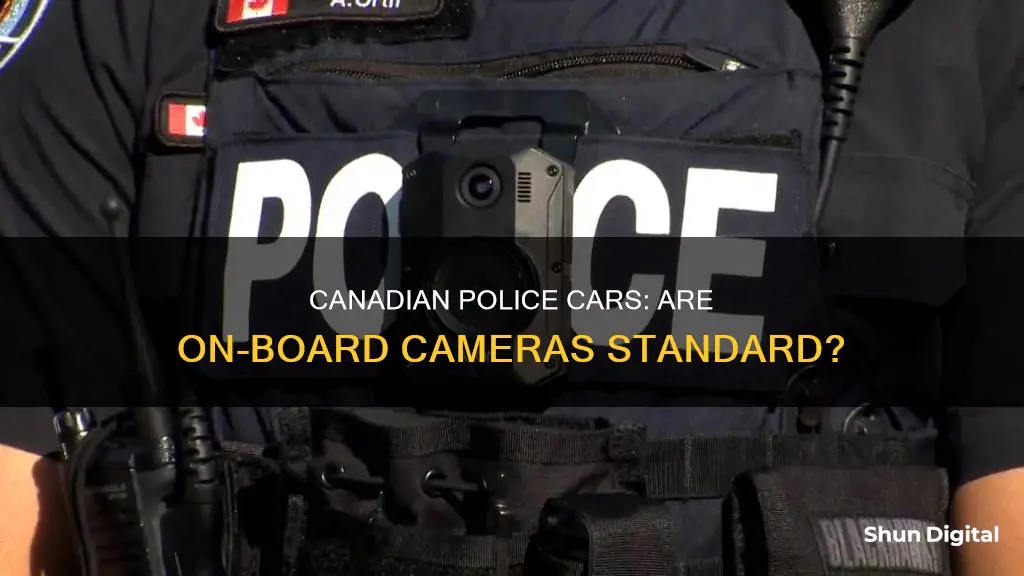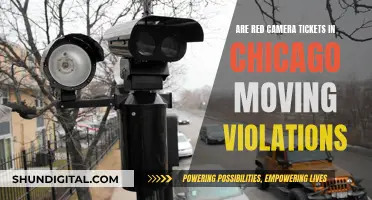
The use of cameras by police in Canada is a topic that has gained traction in recent years, with the Royal Canadian Mounted Police (RCMP) rolling out body-worn cameras and in-car cameras for police officers across the country. The use of body-worn cameras by police officers aims to increase transparency, accountability, and trust between police and the communities they serve. In-car cameras, on the other hand, are often used in conjunction with an automatic license plate reader (ALPR) system, which helps in capturing license plate information and running it against various databases to identify vehicles of interest. While the use of body-worn and in-car cameras by police has its benefits, there are also concerns related to privacy, cost, and the potential for abuse or manipulation of footage.
| Characteristics | Values |
|---|---|
| Do Canadian police cars have cameras? | There is no definitive answer, but sources suggest that Canadian police cars may have cameras in some jurisdictions. One source mentions the RCMP using body-worn cameras and dash cams. |
| Purpose of cameras | The cameras are used for automatic license plate reading, improving transparency and accountability, and capturing interactions between police and the community. |
| Benefits of body-worn cameras | Reduced complaints against officers, improved arrest rates and cooperation from the public, quicker resolution of public complaints, improved training material for officers, and combatting institutional subculture. |
| Drawbacks of body-worn cameras | High implementation costs, short battery life, vulnerability to equipment malfunction, increased stress and burnout for officers, potential invasion of privacy, and potential for bias and ambiguity in footage interpretation. |
What You'll Learn

Police dash-cams are not standard in Canada
In a case from the Ontario Court of Justice, Justice Harris highlighted the advantages of dash-cams in police cars. He noted that video footage could have shortened or even eliminated certain trial proceedings by providing clear evidence of events. This would also help to free up court time and resources. Despite this, most police forces in Canada do not currently utilize dash-cam technology.
The Royal Canadian Mounted Police (RCMP) is taking steps towards implementing body-worn cameras for its officers across the country. Between 10,000 and 15,000 body-worn cameras will be deployed to front-line contract and federal police officers who interact with communities in various locations. This initiative is part of the RCMP's Vision150 modernization plan to strengthen transparency, accountability, and public trust.
However, the use of body-worn cameras by police officers is not without its drawbacks and concerns. One of the main arguments against body-worn cameras is the potential invasion of privacy for citizens. There are also technical limitations, such as short battery life and high implementation and maintenance costs. Additionally, the effectiveness of body-worn cameras in reducing excessive use of force by officers is still uncertain, with limited research showing mixed results.
While dash-cams and body-worn cameras can provide valuable evidence and increase transparency, their implementation in Canadian police forces is not yet widespread or standardized.
HP Camera Battery Drain: Tips to Conserve Power
You may want to see also

Body-worn cameras are being rolled out to RCMP officers
The Royal Canadian Mounted Police (RCMP) will implement a Body-Worn Camera Program to improve public transparency and accountability and to address concerns about policing from racialized and Indigenous communities. The program aims to deploy body-worn cameras to all RCMP officers who interact with the public, totalling between 10,000 and 15,000 cameras. This includes front-line police officers who account for over 90% of use-of-force encounters documented.
The RCMP conducted a pilot project for body-worn cameras in Iqaluit, Nunavut, which concluded on May 31, 2021, involving 24 officers. The project aimed to gather information, including community needs and concerns, and to assess training requirements and policy development.
In October 2022, the RCMP published a new body-worn camera operational policy ahead of the camera rollout. The policy outlines the use of body-worn cameras, as well as the roles and responsibilities of RCMP officers. The RCMP is committed to ensuring that Canadians feel protected by and have trust in their national police force.
The body-worn cameras are expected to strengthen transparency, accountability, and public trust, while also improving evidence gathering and interactions between the public and the police. The video evidence collected will provide an independent, unbiased, and objective record of interactions between police officers and community members.
The rollout of body-worn cameras to RCMP officers will be a gradual process, with plans to outfit Mounties in select communities starting in the fall. This initiative has received strong support, with 94% of respondents perceiving that body-worn cameras will enhance transparency, increase accountability, and build trust in RCMP officers.
Mastering Pixel Camera Focus: Tips for Sharp Photos
You may want to see also

Cameras on police cars can be used for automatic license plate reading
ALPRs can be used to find out where a plate has been in the past, determine whether a vehicle was at the scene of a crime, identify travel patterns, and even discover vehicles that may be associated with each other. This technology can be used to target drivers who visit sensitive places such as health centers, immigration clinics, gun shops, union halls, protests, or centers of religious worship.
Law enforcement agencies can choose to share their information with thousands of other agencies. Taken in aggregate, ALPR data can paint an intimate portrait of a driver's life and chill First Amendment-protected activity. While ALPRs have been used to recover stolen cars or find abducted children, they have also been used for mass enforcement of less serious offenses, such as searching for uninsured drivers or tracking down individuals with overdue court fees.
There are concerns about the accuracy, bias, and protective legal values of ALPRs. Errors can arise from inaccurate hot lists and inaccurate reads, with one study finding a high error rate of 35-37%. In several high-profile incidents, drivers have been pulled over or even detained because a reader misread their license plates. ALPRs can also be deployed to target communities of color or other vulnerable populations, and there are concerns about the impact on protected First Amendment rights.
Chicago Camera Tickets: What You Need to Pay
You may want to see also

Police cameras can reduce complaints against officers
Police body-worn cameras have been shown to reduce the number of complaints against officers. A Cambridge University study showed that complaints by members of the public against officers fell by 93% over 12 months compared with the year before. The research, led by Dr Barak Ariel, found that no other policing measure had led to such "radical" changes.
The use of body-worn cameras has been found to improve transparency and accountability, which may improve law enforcement legitimacy. In many communities, there is a lack of trust and confidence in law enforcement, and body-worn cameras can help to address this issue. The cameras provide an independent, unbiased, and objective way to capture interactions between the community and police officers, leading to increased trust.
Body-worn cameras can also help resolve interactions between the police and civilians that are taken to court. Video evidence can save a significant amount of time and resources in investigating public complaints against police officers. This can help reduce the volume of court cases in overloaded court systems.
In addition, footage from body-worn cameras can be used as training material for police officers. It can provide valuable data for researchers to analyze police-civilian interactions and develop training programs to improve police practices over time.
However, there are also some drawbacks and concerns with the use of body-worn cameras. One concern is the weak enforcement and accountability structures. Without a robust policy framework to regulate the handling, editing, and recording of footage, body-worn cameras may be vulnerable to abuse and may not achieve greater accountability among police forces. There are also privacy concerns, as body-worn cameras can record inside people's homes and collect personal information.
Overall, while police body-worn cameras offer many potential benefits, further research is needed to fully understand their effectiveness and impact on policing.
Understanding Stereo Mode in Camera: Enhancing Your Photography
You may want to see also

Police cameras can reduce arrest rates
Police body-worn cameras have been gaining traction in Canada and the United States, with several police departments adopting the technology to increase transparency and accountability. While there is limited research on the effectiveness of body-worn cameras, some studies suggest that they can help reduce arrest rates and bring about a positive change in police behaviour.
Benefits of Body-Worn Cameras
Research has shown that the use of body-worn cameras can reduce the number of complaints against police officers and improve cooperation with the police. Body-worn cameras provide an independent and objective way to capture interactions between the community and police officers, thereby increasing trust and reducing complaints.
Impact on Arrest Rates
Body-worn cameras have been found to reduce arrest rates in some cases. For example, a study in Boston, Massachusetts, showed a reduction in citizen complaints and police use-of-force reports for officers wearing cameras. Additionally, a study in Phoenix, Arizona, found mixed results, with a decrease in citizen complaints but an increase in the use of force. These mixed findings suggest that further research is needed to understand the impact of body-worn cameras on arrest rates.
Other Considerations
While body-worn cameras offer several benefits, there are also some concerns and limitations to their use. One concern is the impact on officer privacy and the potential for abuse if there is no robust policy framework to regulate the handling of footage. Additionally, the cost of purchasing and maintaining body-worn cameras can be significant, and there may be challenges with battery life and storage of footage.
Body-worn cameras have the potential to bring positive change and reduce arrest rates by improving transparency and accountability. However, further research and careful consideration of the benefits and limitations are needed to fully understand their impact.
The Evolution of Photography: First Camera's Birth
You may want to see also
Frequently asked questions
Canadian police cars may have cameras on the trunks and roofs, which are used for automatic license plate reader (ALPR) systems. However, the presence of cameras varies across police departments, and dash cams are not consistently used.
These systems snap pictures of license plates and run them through various databases to check for registration issues, All-points Bulletins, or other alerts.
These systems have proven effective in stopping crimes and locating vehicles of interest. For example, in 2017, ALPR data helped locate a car and gather DNA samples that led to the arrest of a murderer.
The Royal Canadian Mounted Police (RCMP) is rolling out body-worn cameras to officers across the country. The use of body-worn cameras aims to strengthen transparency, accountability, and public trust.
Body-worn cameras can help resolve public complaints, improve interactions between the public and police, and enhance evidence gathering. Research has also shown that the use of body-worn cameras has reduced complaints against police officers and improved arrest rates and cooperation with police.







